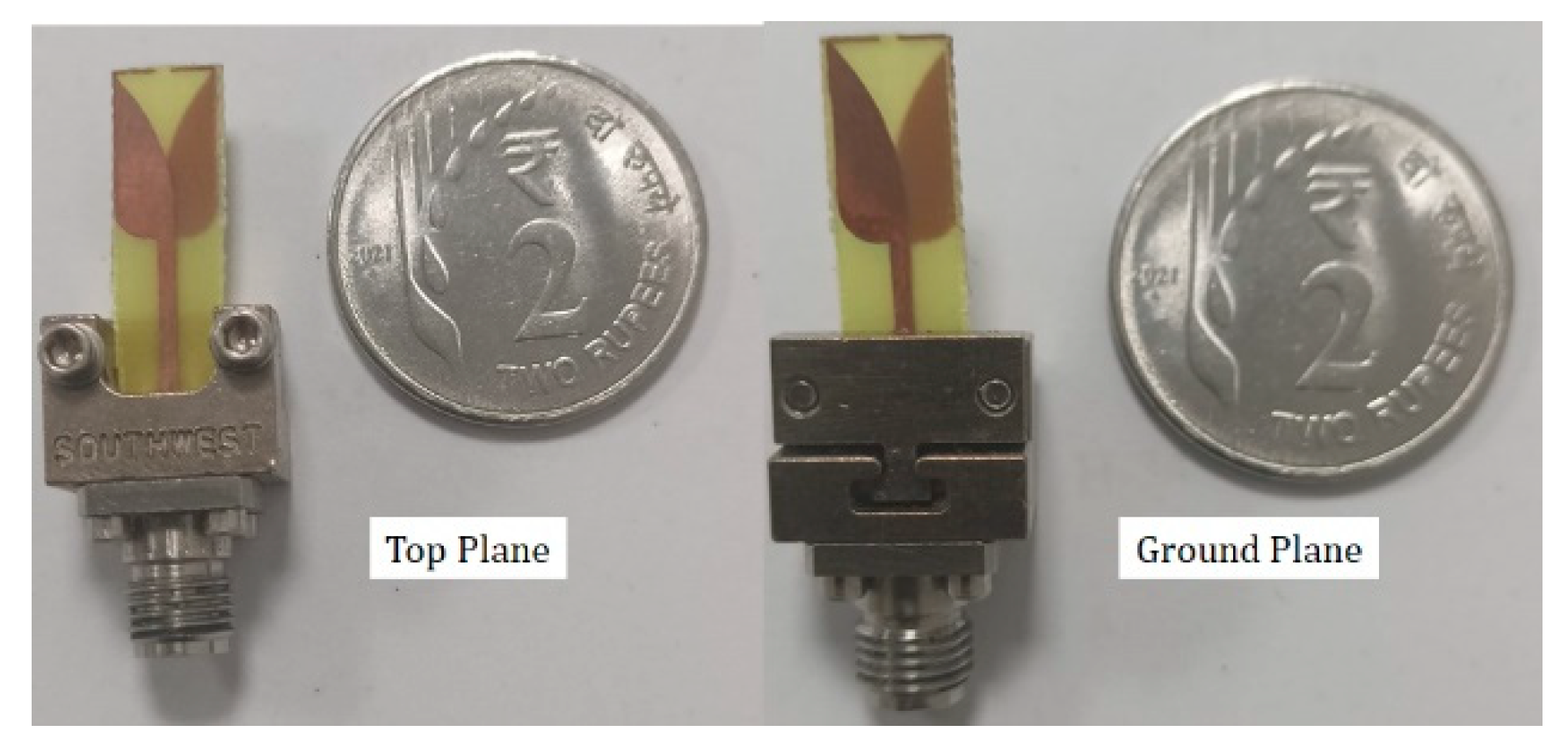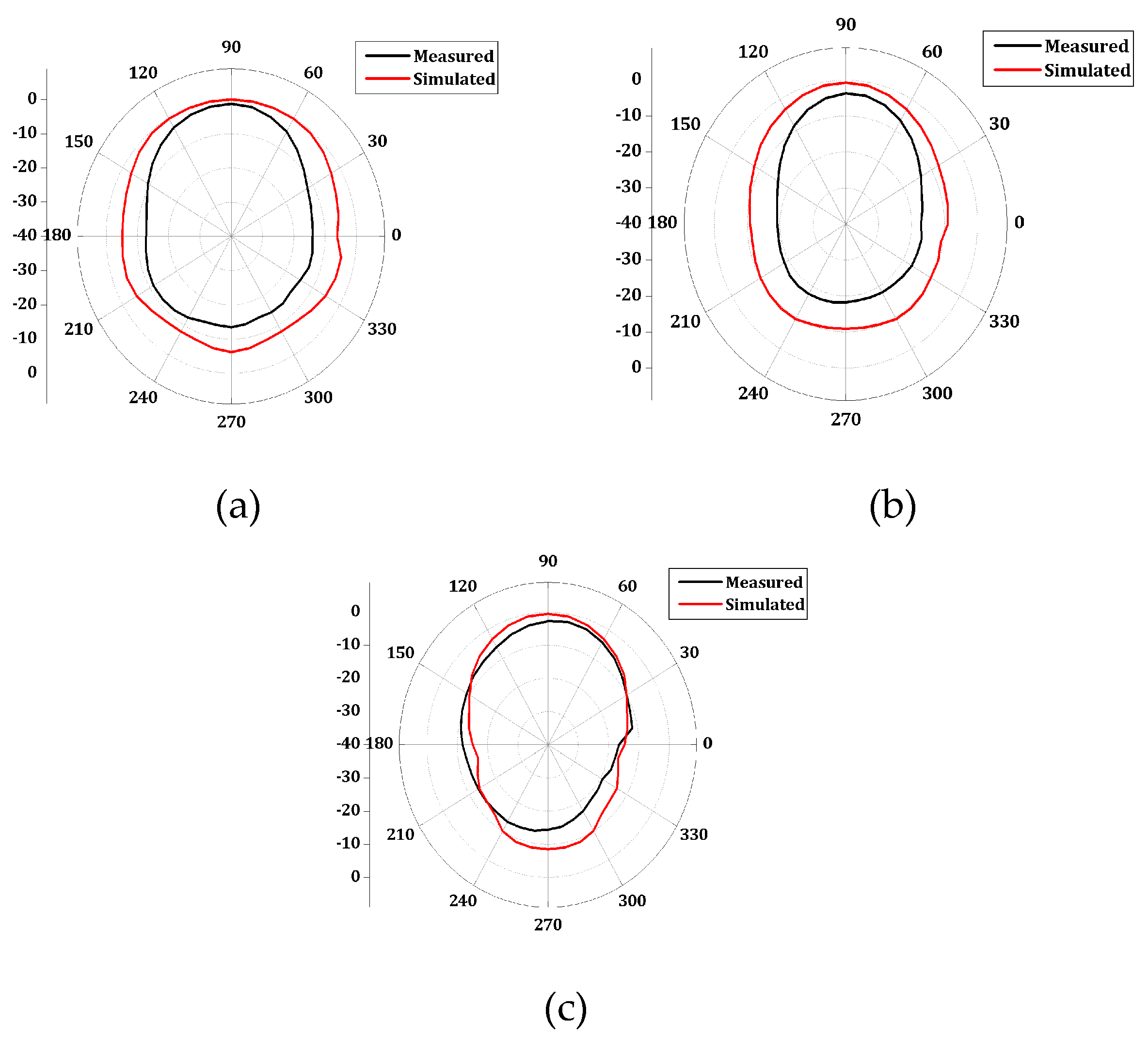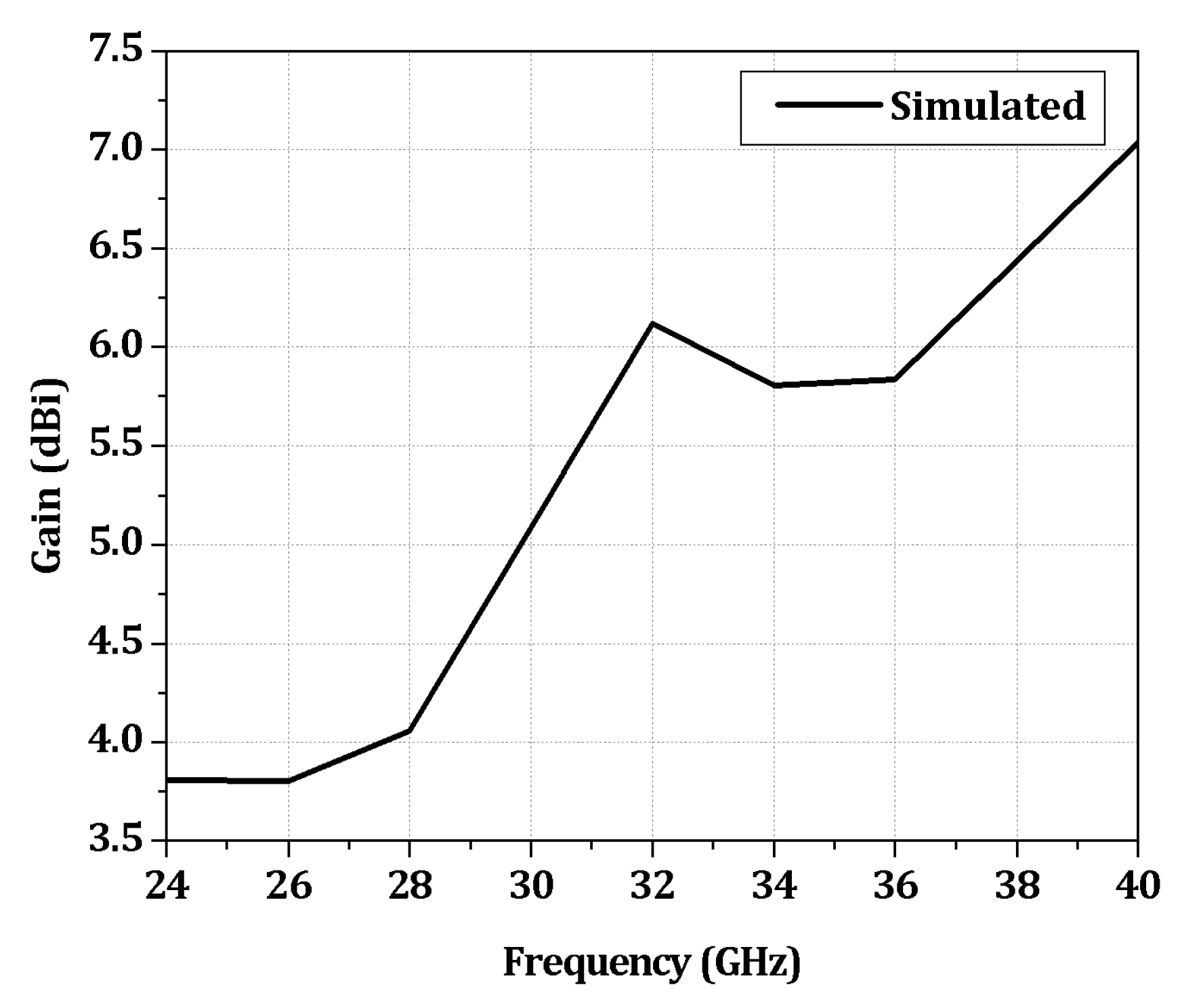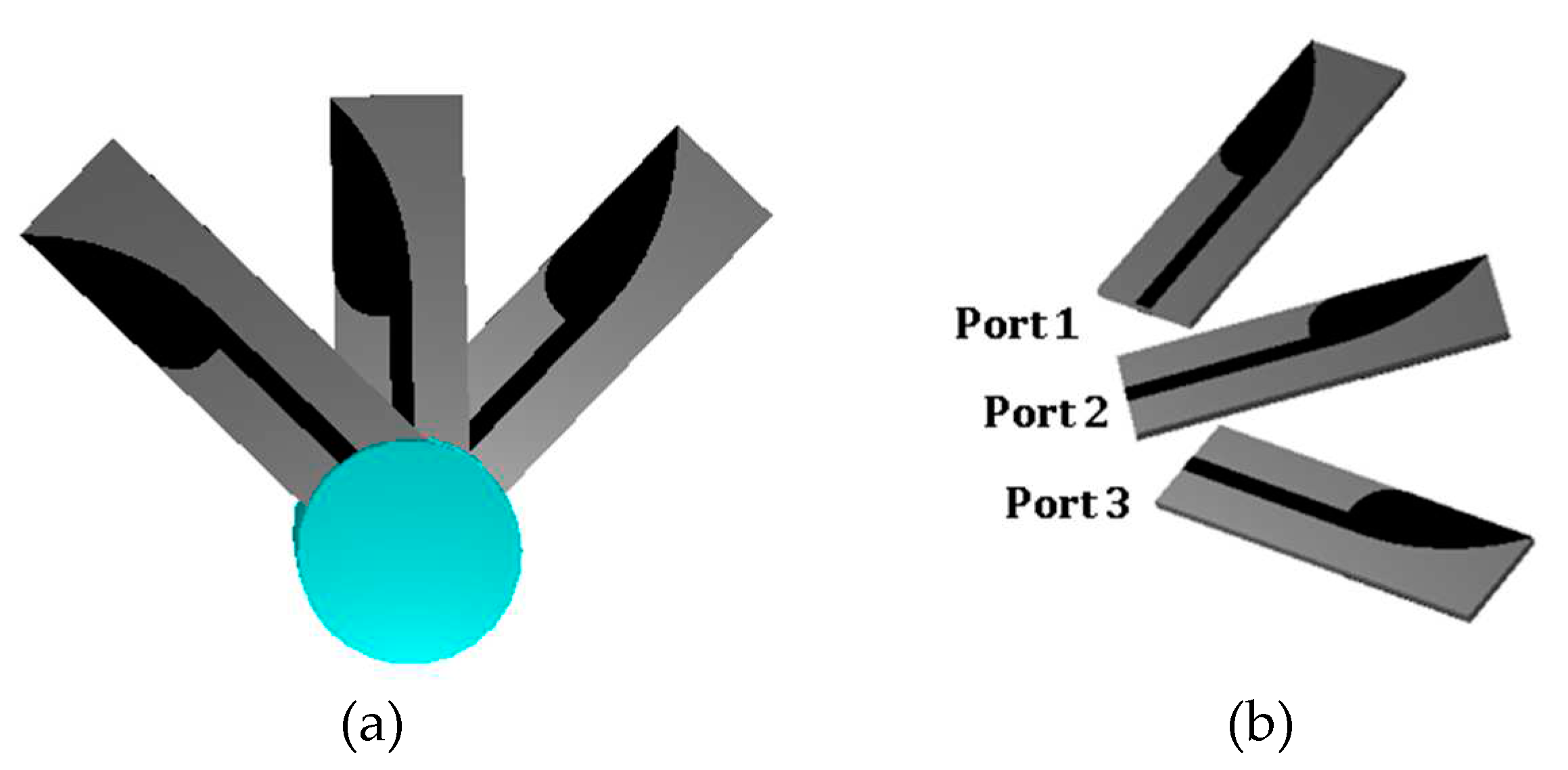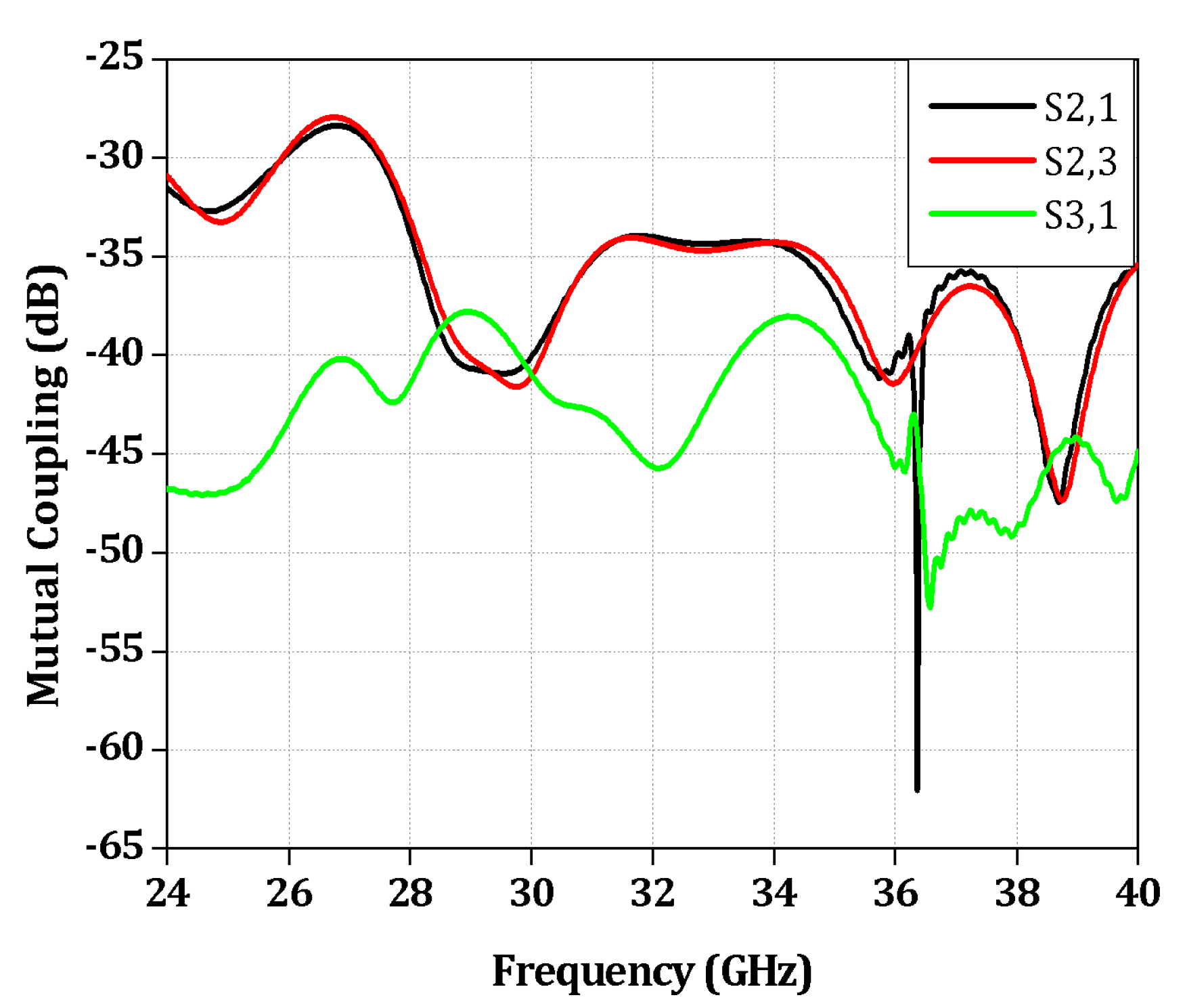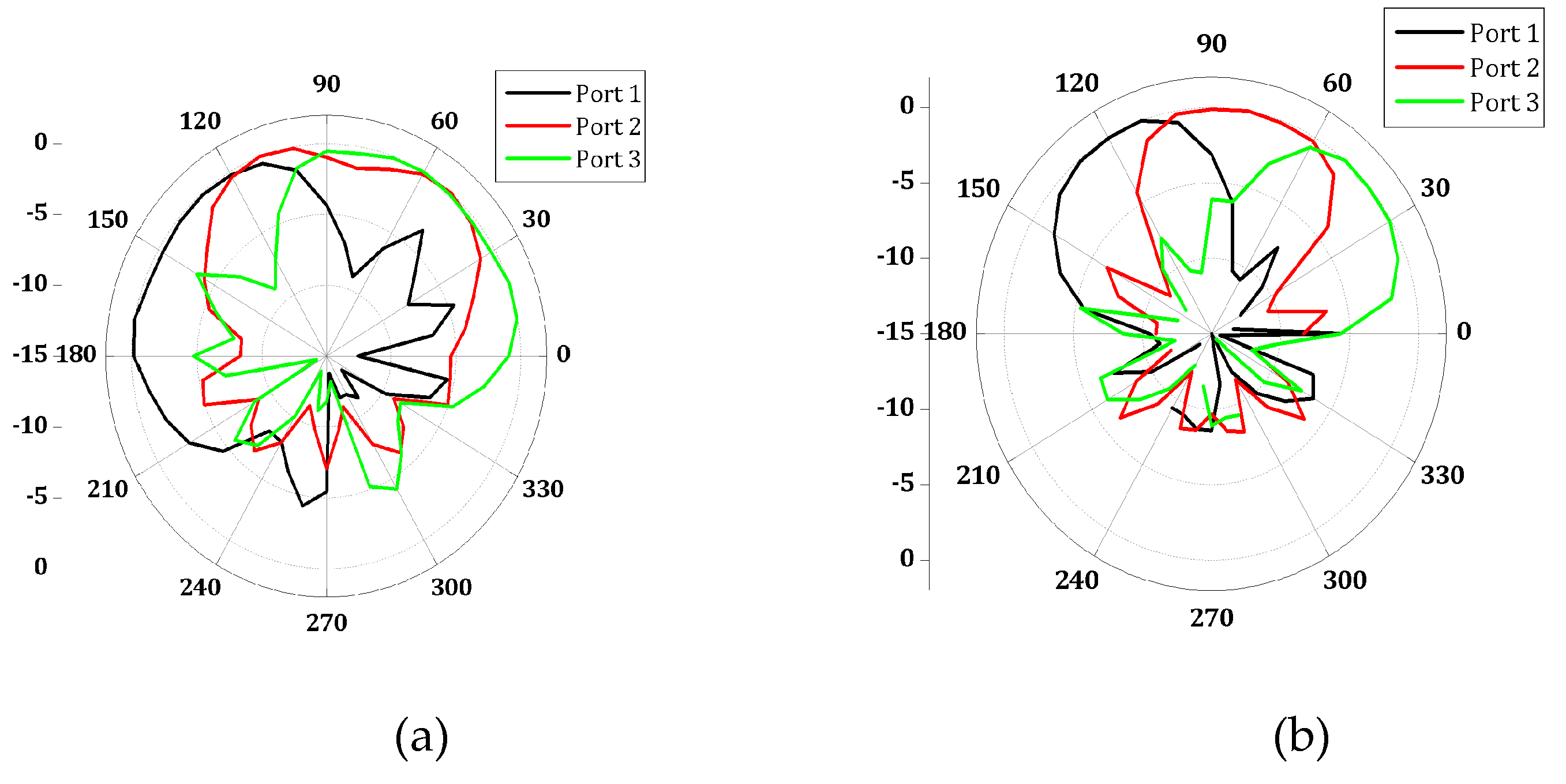1. Introduction
With the onset of higher wireless standards on the commercial stage, it is imperative and intuitive to design wireless systems that are compliant with future protocols. One of the most talked about wireless standards is the 5G technology with higher carrier frequencies [
1]. The current commercial wireless devices are built with sub-6GHz carrier frequencies. The hardware designs for sub-6GHz are well-known and have been in the industry for over a decade now [
2]. With the arrival of 5G wireless standards, hardware pundits predict the growth and deployment of millimeter wave based cellular links. The major concern with millimeter wave based technologies is the relatively high path loss compared to its 4G-LTE (Long Term Evolution) counterpart. The reason for this phenomenon is the operating frequency of the millimeter wave systems. It is proposed that 28GHz bands would be useful for cellular communications. On the other hand, 4G systems operate in the 0.7 to 2.7 GHz. This frequency translation would imply that an additional free space path loss of 20 to 25dB would be encountered with the communication links.
To nullify the effect of the additional path loss encountered, the power could be boosted at the base station or the mobile phone [
3]. This approach would be unsustainable in the long run. It must also be noted that higher transmission power at the mobile device would mean that the battery of the device would drain out quickly and creates inconvenience to the consumers.
The popular strategy to mitigate path loss and absorption losses at millimeter wave frequencies is to simultaneously enhance gains of the antenna system at the transmitting and receiving ends. In other words, the path loss issue could be resolved by increasing the gain of the antenna at the mobile device and the base station [
4,
5,
6,
7,
8,
9,
10,
11,
12,
13,
14,
15]. The available space to integrate antennas is very limited in the mobile terminal, hence antennas with high aperture efficiency have to be designed and incorporated. On the other hand, the antennas to be deployed in the base stations must possess the following features:
Economical: the cost of the antenna system must be low, as these devices would be scaled for an entire geographical location
Wide angular coverage: the purpose of installing a base station is to provide high coverage for the available real estate
Manufacturability: the process of fabrication of the antennas must be commercially viable
Scalability: the design and fabrication processes must be compliant with that of the antenna systems of the previous wireless generations
In order to comply with these features, numerous designs have been published in the literature. A 28GHz multi-element is proposed in [
1], this design lacks a wide-angular coverage. A T-shaped antenna is presented in [
2], the design could be scaled or optimized for base station applications, but would yield low gain compared to the travelling antennas. A dual-band microstrip fed antenna is demonstrated in [
3], even though the antenna operates in multiple bands the gain for the available radiating aperture is low. A modified phased array approach is shown in [
4], the scanning loss is close to 4dB, which makes it unsuitable for base station applications. A wide band antenna operating in the 28GHz band is presented in [
5], the pattern integrity across the band is poor.
Even though the antenna presented in [
6] is compact, the gain and pattern integrity is compromised. Antennas presented in [
7,
8,
9]. A high efficiency antenna system with multi-polarization is proposed in [
10], it is designed on an expensive substrate with multiple fabrication technologies.
Application of defected ground structures result in poor pattern integrity across the band, as illustrated in [
11]. A broadband high gain antenna is presented in [
12], beam switching feature is missing. A 77 GHz antenna for radar sensor is published in [
13], scaling this design for 28GHz would lead to increased manufacturing costs. Wideband antennas with lower gains are presented in [
14,
15].
In this paper, an ultra-wideband antenna with antipodal topology is presented. The antenna is realized on a low cost substrate.
The introduction should briefly place the study in a broad context and highlight why it is important. It should define the purpose of the work and its significance. The current state of the research field should be carefully reviewed and key publications cited. Please highlight controversial and diverging hypotheses when necessary. Finally, briefly mention the main aim of the work and highlight the principal conclusions. As far as possible, please keep the introduction comprehensible to scientists outside your particular field of research. References should be numbered in order of appearance and indicated by a numeral or numerals in square brackets—e.g., [
1] or [
2,
3], or [
4,
5,
6]. See the end of the document for further details on references.
2. Ultra-wideband Antipodal Antenna
The schematics of the proposed antipodal antenna are displayed in
Figure 1. The antipodal antenna is realized on the industrially available, economical FR4 substrate. The substrate has a dielectric constant of 4.4 with a corresponding loss tangent of 0.02. On the outset, the substrate appears to be lossy at high frequencies. This phenomenon would aggravate with the substrate thickness. Hence, in order to mitigate the surface wave modes and the dielectric loss, an electrically thin substrate is chosen. The substrate thickness is 0.5mm, which translates to approximately 0.05λ at 28GHz. Hence, the antenna is realized on an electrically thin substrate. The dielectric constant aids in miniaturization of the radiator. The feed is 1mm, which is matched to the 50Ω port impedance.
The feed line is tapered to the arms of the antipodal antenna. The tapering contour has been optimized to achieve maximum gain for the available physical footprint.
The ground plane is a mirror image of the top plane. The photograph of the fabricated prototype along with the connector is shown in
Figure 2. The industry standard photo-lithography technique was used to fabricate the proposed element. The 2.92mm end-launch connector was used for measurement purposes. The entire assembly is shown in the figure. It must be noted that the commercial substrate FR4 with a thickness of 1.6mm was not used for this application, due to the high cross-pol radiation emanating from the substrate alone.
The input reflection coefficient of the proposed antenna is shown in
Figure 3. The simulated 10-dB impedance bandwidth is from 26GHz to 40GHz, translating to 42%. The wide bandwidth could be attributed to the design of the tapering aperture of the antipodal antenna on the electrically thin substrate. It must be noted that several published works achieve similar performance of impedance bandwidth with the application of wideband baluns and other complicated feed network. In the proposed design, a simple transmission line is impedance transformed to the radiating arms of the antipodal antenna. The discrepancy between the simulated and measured values could be attributed to the slight deviation of the dielectric constant of the substrate used. The alignment error between the solder-less connector and the fabricated prototype also leads to minor errors in the measurement. The measurements were carried out with R&S ZNB40. The port was properly calibrated prior to the measurements.
The radiation patterns of the proposed antenna are illustrated in
Figure 4 and
Figure 5. Both the E-plane and H-plane patterns have been illustrated. The patterns across the operating band have a high front to back ratio, greater than 10 dB. The radiation patterns were measured inside an anechoic chamber that is rated up to 40 GHz. All the simulations were done with Ansys Electronics 2015.2
The forward gain of the proposed antenna is illustrated in
Figure 6. The gain varies from 4 to 7.5 dBi. The gain variation is acceptable given the ultra-wideband operation. The gain increases due to the variation in the electrical size of the aperture. The proposed element offers high gain for the occupied real estate. It must be noted that the 3-dB gain bandwidth is almost identical to the 10-dB impedance bandwidth.
3. Multi-step Antipodal Antennas
The proposed antenna is extended to a multi-step architecture. This multi-port design is demonstrated to achieve wideband pattern diversity and to achieve wide-angle coverage. The proposed layout for the multi-step is shown in
Figure 7. The elements are mounted at a distance of 8mm from each other. This distance is a compromise for the mutual coupling between the ports and the radiation patterns.
One of the ports would be activated, depending on the user’s requirement. It must be noted that the multi-step topology is optimized for minimal mutual coupling.
The fabricated prototype of the multi-step architecture is illustrated in
Figure 8. A PLA (Polylactic acid) based 3D-printed support structure was designed to accommodate the three ports of the identical antennas. In a real-world deployment scenario, customized connectors could be mounted with the elements to achieve the pattern diversity or wide angular coverage.
The mutual coupling plots are shown in
Figure 9. The mutual coupling is less than 25dB across the entire 42% band. This could be attributed to the optimized topology of the antennas and its respective high gain. It must also be noted that the impedance characteristics of the single and its multi-step counterpart is almost identical. As the mutual coupling is minimal, the input reflection coefficients of the other elements remain intact.
The radiation patterns of the multi-step architecture at 24 GHz and 34 GHz is shown in
Figure 10. It is evident that the proposed topology offers a wide angular coverage across the bandwidth.
Table 1 illustrates the performance metrics of the proposed topologies over the existing designs, published in the literature. It is evident that the proposed antenna is realized on an inexpensive substrate with industrial manufacturing process. The multi-step topology also delivers wide angular coverage.
4. Conclusions
In this article, an ultra-wideband antenna element is proposed. The antenna is realized on a low cost substrate with commercial manufacturing process. The antenna operates from 26 to 40 GHz, with an on-axis gain of more than 4dBi across the operating band. A multi-step topology of the proposed antipodal antenna is also presented in this paper. The proposed antenna system could be a potential candidate for future mmWave 5G applications.
Funding
“This research received no external funding”.
Conflicts of Interest
“The authors declare no conflict of interest.”
References
- Wani Z, Abegaonkar MP, Koul SK. A 28-GHz antenna for 5G MIMO applications. Progress In Electromagnetics Research Letters. 2018;78:73-9. [CrossRef]
- Kiani SH, Ren XC, Bashir A, Rafiq A, Anjum MR, Kamal MM, Din BU, Muhammad F. Square-framed T shape mmwave antenna array at 28 GHz for future 5G devices. International Journal of Antennas and Propagation. 2021 Sep 13;2021:1-9. [CrossRef]
- Raheel K, Altaf A, Waheed A, Kiani SH, Sehrai DA, Tubbal F, Raad R. E-shaped H-slotted dual band mmWave antenna for 5G technology. Electronics. 2021 Apr 25;10(9):1019. [CrossRef]
- Kamal MM, Yang S, Kiani SH, Anjum MR, Alibakhshikenari M, Arain ZA, Jamali AA, Lalbakhsh A, Limiti E. Donut-shaped mmWave printed antenna array for 5G technology. Electronics. 2021 Jun 12;10(12):1415. [CrossRef]
- Kamal MM, Yang S, Kiani SH, Sehrai DA, Alibakhshikenari M, Abdullah M, Falcone F, Limiti E, Munir M. A novel hook-shaped antenna operating at 28 GHz for future 5G mmwave applications. Electronics. 2021 Mar 12;10(6):673. [CrossRef]
- Kumar P, Ali T, Kumar OP, Vincent S, Kumar P, Nanjappa Y, Pathan S. An ultra-compact 28 GHz arc-shaped millimeter-wave antenna for 5G application. Micromachines. 2022 Dec 20;14(1):5. [CrossRef]
- Khattak MI, Sohail A, Khan U, Barki Z, Witjaksono G. Elliptical slot circular patch antenna array with dual band behaviour for future 5G mobile communication networks. Progress In Electromagnetics Research C. 2019;89:133-47. [CrossRef]
- Zahra H, Awan WA, Ali WA, Hussain N, Abbas SM, Mukhopadhyay S. A 28 GHz broadband helical inspired end-fire antenna and its MIMO configuration for 5G pattern diversity applications. Electronics. 2021 Feb 7;10(4):405. [CrossRef]
- Awan WA, Naqvi SI, Naqvi AH, Abbas SM, Zaidi A, Hussain N. Design and characterization of wideband printed antenna based on DGS for 28 GHz 5G applications. Journal of Electromagnetic Engineering and Science. 2021 Jul 31;21(3):177-83. [CrossRef]
- KR Mahmoud and AM Montaser, "Performance of tri-band multi-polarized array antenna for 5G mobile base station adopting polarization and directivity control," IEEE Access, vol. 6, pp. 8682–8694, 2018. [CrossRef]
- M Khalid, SI Naqvi, N Hussain, M Rahman, SS Mirjavadi, MJ Khan and Y Amin, "4-Port MIMO antenna with defected ground structure for 5G millimeter wave applications," Electronics, vol. 9, no. 1, article no 71, 2020. [CrossRef]
- N. Hussain, M. J. Jeong, J. Park, and N. Kim, "A broadband circularly polarized Fabry-Perot resonant antenna using a single-layered PRS for 5G MIMO applications," IEEE Access, vol. 7, pp. 42897-42907, 2019. [CrossRef]
- Hasch, J.; Topak, E.; Schnabel, R.; Zwick, T.; Weigel, R.; Waldschmidt, C. Millimeter-wave technology for automotive radar sensors in the 77 GHz frequency band. IEEE Trans. Microw. Theory Tech. 2012, 60, 845–860. [Google Scholar] [CrossRef]
- Zhao, L.; Chen, Z.-M.; Wang, J. A Wideband Dual-Polarized Omnidirectional Antenna for 5G/WLAN. IEEE Access 2019, 7, 14266–14272. [Google Scholar] [CrossRef]
- Ghazaoui, Y.; Alami, A.E.; Ghzaoui, M.E.; Das, S.; Barad, D.; Mohapatra, S. Millimeter wave antenna with enhanced bandwidth for 5G wireless application. J. Instrum. 2020, 15, T01003. [Google Scholar] [CrossRef]
|
Disclaimer/Publisher’s Note: The statements, opinions and data contained in all publications are solely those of the individual author(s) and contributor(s) and not of MDPI and/or the editor(s). MDPI and/or the editor(s) disclaim responsibility for any injury to people or property resulting from any ideas, methods, instructions or products referred to in the content. |
© 2023 by the authors. Licensee MDPI, Basel, Switzerland. This article is an open access article distributed under the terms and conditions of the Creative Commons Attribution (CC BY) license (http://creativecommons.org/licenses/by/4.0/).

